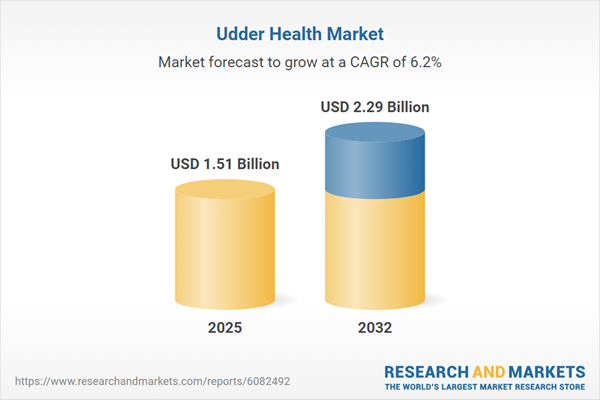Speak directly to the analyst to clarify any post sales queries you may have.
The udder health market is rapidly evolving, driven by technological advances, new regulatory measures, and a stronger focus on sustainable dairy production. As animal welfare standards rise and operational demands increase, industry leaders are seeking actionable insights and proven strategies to maintain competitive advantage while ensuring consistent supply chain performance.
Market Snapshot: Udder Health Market Size and Growth
The udder health market grew from USD 1.42 billion in 2024 to USD 1.51 billion in 2025. It is expected to continue growing at a CAGR of 6.17%, reaching USD 2.29 billion by 2032. Growth is fueled by advancements in biosensor technology, increasing demand for traceability, and regulatory shifts emphasizing antimicrobial stewardship. Producers worldwide are adopting advanced protocols for early detection, prevention, and treatment, as insurance against escalating cost pressures and evolving supply chain needs.
Scope & Segmentation
This market research offers granular segmentation analysis to inform business strategy and investment plans. Coverage includes:
- Product Types:
- Antimicrobials
- Teat Dips
- Vaccines
- Animal Types:
- Buffalo
- Dairy Cows
- Goats
- Application Modes:
- Post-Milking
- Pre-Milking
- Distribution Channels:
- Online
- Pharmacy
- Veterinary Distributors
- Farm Sizes:
- Large Farms
- Medium Farms
- Small Farms
- Regions:
- Americas: United States, Canada, Mexico, Brazil, Argentina, Chile, Colombia, Peru
- Europe, Middle East & Africa: United Kingdom, Germany, France, Russia, Italy, Spain, Netherlands, Sweden, Poland, Switzerland, United Arab Emirates, Saudi Arabia, Qatar, Turkey, Israel, South Africa, Nigeria, Egypt, Kenya
- Asia-Pacific: China, India, Japan, Australia, South Korea, Indonesia, Thailand, Malaysia, Singapore, Taiwan
- Notable Companies:
- Zoetis Inc.
- Boehringer Ingelheim International GmbH
- Elanco Animal Health Incorporated
- Merck & Co., Inc.
- Ceva Santé Animale S.A.
- Vetoquinol S.A.
- DeLaval A.B.
- GEA Group Aktiengesellschaft
- Neogen Corporation
- Thermo Fisher Scientific Inc.
Key Takeaways
- Emerging biosensor and data analytics solutions are enabling real-time herd monitoring and early intervention, improving treatment outcomes and reducing losses from subclinical mastitis.
- Antimicrobial stewardship and rising demand for alternatives, such as vaccines and immunomodulators, are influencing product innovation pipelines across major regions.
- Species-specific protocols and formulations are gaining traction as producers seek customized approaches for buffalo, dairy cows, and goats.
- Distribution landscapes are shifting, with online channels expanding global reach, while veterinary partners and pharmacies continue to provide localized expertise in both large and small-scale operations.
- Strategic partnerships between leading life sciences companies and academic research institutions are accelerating the validation and commercialization of next-generation udder health solutions.
- Industry consolidation and technology integration are fostering competitive differentiation, with firms leveraging cloud platforms and predictive maintenance to support comprehensive herd health programs.
Assessing Tariff Impact on the Udder Health Market
The imposition of U.S. tariffs in 2025 has raised input costs for critical reagents, diagnostics, and sensor components, compelling manufacturers to adapt sourcing and supply chain strategies. Tariff-related cost increases are influencing purchasing behavior across the value chain, leading to postponed equipment upgrades and renewed focus on cost-benefit optimization in preventive care investments. These trade measures underscore the importance of adaptable procurement and supply chain resilience in maintaining access to innovative udder health technologies.
Research Methodology & Data Sources
This report utilizes a combination of primary and secondary research. Stakeholder interviews, on-farm observations, and expert panels complement data from peer-reviewed publications, industry reports, and regulatory documents. Multi-stage data validation and scenario analysis strengthen reliability and practical relevance.
Why This Report Matters
- Enables strategic planning for adopting next-generation udder health interventions and technology platforms.
- Provides region- and species-specific market intelligence to inform expansion, procurement, and partnership decisions.
- Supports decision-makers in navigating regulatory changes affecting product innovation, risk mitigation, and animal welfare compliance.
Conclusion
Senior decision-makers can leverage this udder health market analysis to align technology investments, anticipate regulatory changes, and reinforce supply chain performance. By applying these insights, industry leaders position their organizations for sustained growth and innovation within a rapidly evolving dairy sector.
Table of Contents
3. Executive Summary
4. Market Overview
7. Cumulative Impact of Artificial Intelligence 2025
Companies Mentioned
The companies profiled in this Udder Health market report include:- Zoetis Inc.
- Boehringer Ingelheim International GmbH
- Elanco Animal Health Incorporated
- Merck & Co., Inc.
- Ceva Santé Animale S.A.
- Vetoquinol S.A.
- DeLaval A.B.
- GEA Group Aktiengesellschaft
- Neogen Corporation
- Thermo Fisher Scientific Inc.
Table Information
| Report Attribute | Details |
|---|---|
| No. of Pages | 196 |
| Published | October 2025 |
| Forecast Period | 2025 - 2032 |
| Estimated Market Value ( USD | $ 1.51 Billion |
| Forecasted Market Value ( USD | $ 2.29 Billion |
| Compound Annual Growth Rate | 6.1% |
| Regions Covered | Global |
| No. of Companies Mentioned | 11 |









